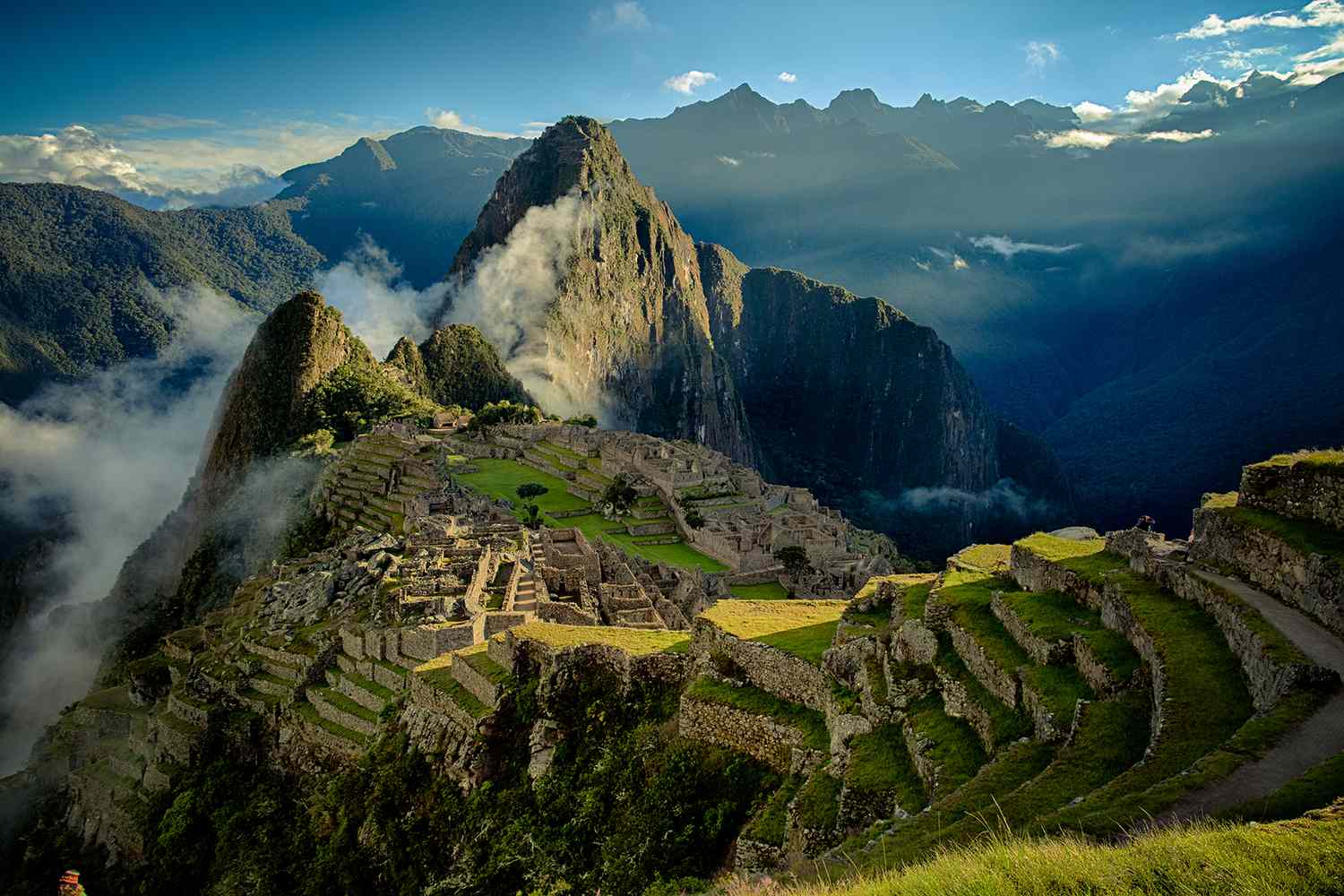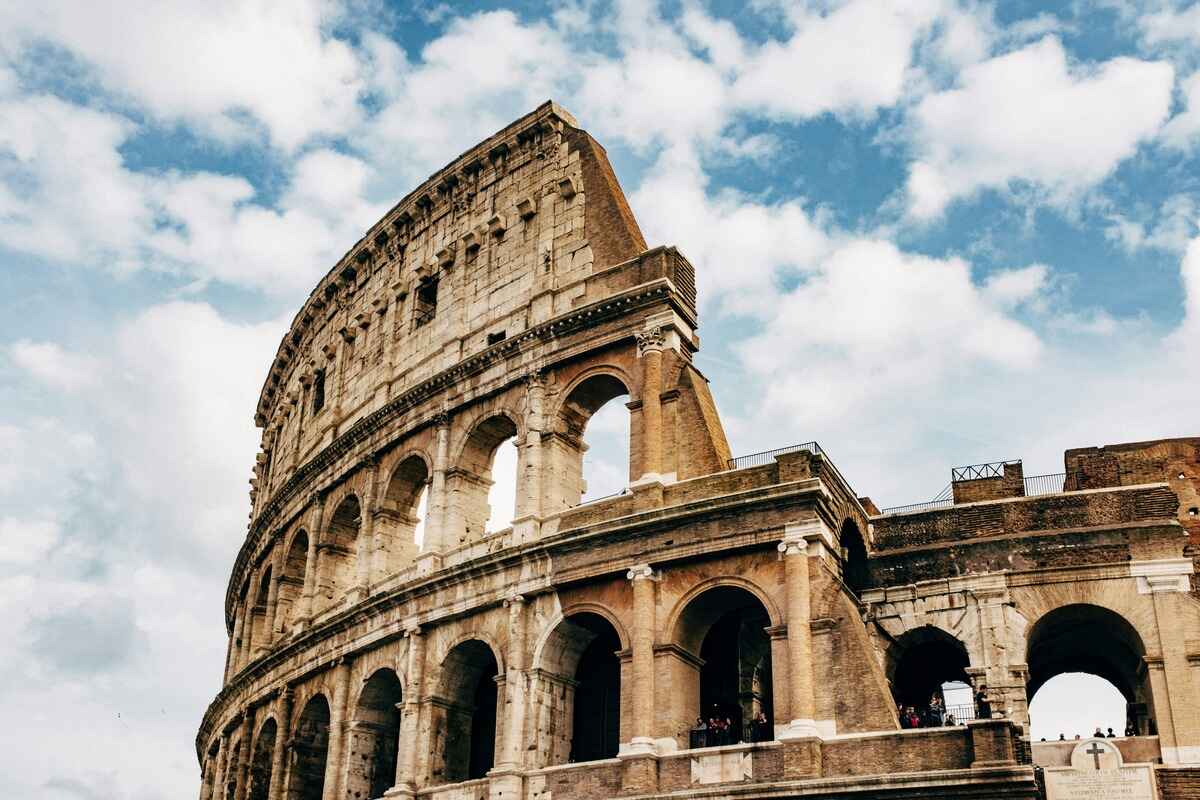Home>Travel and Places>Discover The Most Breathtaking Landscapes On Earth!


Travel and Places
Discover The Most Breathtaking Landscapes On Earth!
Published: February 12, 2024
Explore the world's most stunning landscapes and plan your next adventure with our travel and places guide. Uncover hidden gems and breathtaking natural wonders!
(Many of the links in this article redirect to a specific reviewed product. Your purchase of these products through affiliate links helps to generate commission for Noodls.com, at no extra cost. Learn more)
Table of Contents
Introduction
Welcome to a journey of discovery through some of the most awe-inspiring and breathtaking landscapes on our planet. From the majestic canyons to the vibrant underwater worlds, and from the dancing auroras to the vast deserts, these natural wonders are a testament to the extraordinary beauty and diversity of Earth.
As we embark on this virtual expedition, prepare to be captivated by the sheer grandeur and magnificence of these landscapes. Each destination offers a unique and unforgettable experience, showcasing the remarkable power and artistry of nature. Whether you are an avid traveler, a nature enthusiast, or simply someone who appreciates the splendor of the world around us, these landscapes are sure to leave an indelible impression on your heart and mind.
So, fasten your seatbelts and get ready to be transported to some of the most iconic and mesmerizing locations on Earth. Let's delve into the wonders of the Grand Canyon in the USA, the vibrant underwater realm of the Great Barrier Reef in Australia, the mystical dance of the Northern Lights in Norway, the vast and enigmatic Sahara Desert in Africa, the lush and diverse Amazon Rainforest in South America, the majestic Swiss Alps in Switzerland, the thundering cascades of the Victoria Falls on the border of Zambia and Zimbabwe, the ancient marvel of the Great Wall of China, and the untamed beauty of the Serengeti National Park in Tanzania.
Each of these destinations has a story to tell, a beauty to reveal, and an experience to offer. Join us as we unravel the secrets of these breathtaking landscapes and immerse ourselves in the splendor of nature's finest creations.
The Grand Canyon, USA
The Grand Canyon, located in the state of Arizona, is a natural wonder that defies description. Carved by the mighty Colorado River over millions of years, this colossal chasm stretches for 277 miles and plunges to depths of over a mile. Its sheer size and intricate rock formations make it one of the most iconic and breathtaking landscapes on Earth.
As the sun rises over the canyon, its ancient walls come alive with a kaleidoscope of colors, ranging from deep reds and oranges to soft pinks and purples. The interplay of light and shadow creates a mesmerizing spectacle, casting ever-changing patterns across the rugged terrain. Visitors often gather at popular viewpoints such as Mather Point and Yavapai Observation Station to witness the canyon's transformation under the golden rays of dawn.
Exploring the Grand Canyon offers a myriad of experiences, from exhilarating hikes along the rim to adrenaline-pumping whitewater rafting expeditions within the canyon itself. The South Rim, known for its accessibility and panoramic vistas, attracts millions of visitors each year, while the more remote North Rim offers a quieter, more secluded encounter with this natural marvel.
For those seeking a truly unforgettable adventure, a helicopter tour provides a bird's-eye view of the canyon's vast expanse, revealing its intricate layers and hidden gorges. As the helicopter soars over the rim, passengers are treated to a breathtaking display of geological artistry, with the Colorado River winding like a ribbon through the heart of the canyon.
The Grand Canyon is not only a geological masterpiece but also a sanctuary for diverse flora and fauna. Its ecosystems range from desert scrub to pine forests, providing a habitat for a remarkable array of wildlife, including bighorn sheep, condors, and elusive mountain lions. The park's night skies, free from light pollution, offer stargazers a chance to witness the celestial wonders above, adding another layer of enchantment to this already magical landscape.
In every season and at every vantage point, the Grand Canyon never fails to inspire awe and wonder. Its timeless beauty and profound grandeur remind us of the Earth's enduring power and the boundless artistry of nature. Whether standing at the rim's edge, gazing into the abyss, or embarking on a journey into its depths, the Grand Canyon invites us to connect with the primal forces that have shaped our planet and our souls.
The Great Barrier Reef, Australia
The Great Barrier Reef, located off the coast of Queensland, Australia, is a mesmerizing aquatic wonderland that stretches over 1,400 miles, making it the largest coral reef system on the planet. This natural masterpiece is a kaleidoscope of vibrant colors, teeming with an astonishing diversity of marine life and coral formations.
As one descends into the crystal-clear waters of the Great Barrier Reef, a world of unparalleled beauty unfolds. The reef is a living tapestry of marine ecosystems, encompassing over 2,900 individual reefs and 900 islands. Its intricate coral gardens, adorned with an array of shapes and hues, provide a sanctuary for an astonishing variety of marine creatures, from graceful sea turtles and majestic manta rays to playful clownfish and elusive reef sharks.
Snorkeling and diving in the Great Barrier Reef offer an immersive encounter with this underwater paradise. The warm, tropical waters teem with life, and every dive reveals a new spectacle of color and movement. Exploring the reef's labyrinthine formations, one can witness the delicate dance of coral polyps, the hypnotic undulations of giant clams, and the graceful movements of iridescent fish darting among the coral branches.
For those seeking a more leisurely experience, glass-bottom boat tours and semi-submersible excursions provide a window into the reef's mesmerizing world without getting wet. These tours offer a unique perspective, allowing visitors to marvel at the kaleidoscopic coral gardens and the myriad marine inhabitants from the comfort of a dry, enclosed vessel.
The Great Barrier Reef is not only a visual feast but also a crucial ecosystem that supports a staggering array of marine life. It serves as a vital breeding ground for numerous species of fish, turtles, and marine mammals, contributing to the overall health and biodiversity of the world's oceans. The reef's significance as a global treasure has led to its designation as a UNESCO World Heritage site, recognizing its irreplaceable value to humanity and the planet.
While the Great Barrier Reef's beauty is undoubtedly captivating, it also serves as a poignant reminder of the fragility of our natural world. Threatened by climate change, pollution, and human activity, the reef faces unprecedented challenges. Efforts to preserve and protect this ecological marvel are essential to ensure that future generations can continue to marvel at its splendor.
In every ripple and shimmer, the Great Barrier Reef beckons us to cherish and safeguard the wonders of our oceans. Its irreplaceable beauty and ecological significance inspire a sense of awe and responsibility, urging us to become stewards of our planet's precious natural heritage.
The Northern Lights, Norway
The Northern Lights, also known as the Aurora Borealis, is a celestial phenomenon that has captivated and mystified observers for centuries. Norway, with its pristine Arctic landscapes and clear, dark skies, offers an unparalleled vantage point for witnessing this mesmerizing display of light and color.
As the long Arctic nights descend upon Norway, the stage is set for nature's most enchanting spectacle. The Northern Lights are a result of solar particles colliding with the Earth's atmosphere, creating a luminous dance of ethereal hues across the night sky. The colors range from shimmering greens and blues to radiant purples and pinks, painting an otherworldly canvas that seems to transcend the boundaries of our earthly realm.
The best time to witness the Northern Lights in Norway is during the winter months, when the extended darkness provides optimal conditions for viewing this celestial ballet. The remote regions of Tromsø, Lofoten, and Finnmark offer prime locations for experiencing the full splendor of the auroras. Here, away from the glare of city lights, visitors can immerse themselves in the stillness of the Arctic wilderness and await the magical appearance of the Northern Lights.
Chasing the Northern Lights in Norway is an adventure in itself. Whether embarking on a guided tour or venturing out independently, the thrill of anticipation builds as the night sky comes alive with a symphony of colors. The crackling of a bonfire, the crisp Arctic air, and the sense of wonder that accompanies the appearance of the auroras create an unforgettable experience that lingers in the memory long after the lights have faded.
Photographers and enthusiasts from around the world flock to Norway in pursuit of the perfect Northern Lights shot. Capturing the elusive dance of the auroras against a backdrop of snow-capped mountains, fjords, or traditional Norwegian cabins adds an extra layer of magic to the experience. The interplay of light and landscape creates a visual poetry that transcends words, evoking a profound sense of wonder and reverence for the natural world.
The Northern Lights hold a special place in Norwegian folklore and culture, with ancient myths and legends seeking to explain the origins of this celestial phenomenon. For the indigenous Sami people, the auroras are imbued with spiritual significance, representing the souls of the departed and serving as a source of inspiration and wonder.
In every undulating ribbon of light, the Northern Lights invite us to contemplate the mysteries of the universe and the timeless beauty of the natural world. Norway's Arctic realm provides a front-row seat to this celestial ballet, offering a profound and humbling encounter with one of nature's most extraordinary marvels.
The Sahara Desert, Africa
The Sahara Desert, stretching across North Africa, is the world's largest hot desert, covering an expanse of over 3.6 million square miles. Its vast and enigmatic landscapes evoke a sense of awe and wonder, offering a glimpse into the raw power and timeless beauty of nature.
The Sahara's iconic dunes, sculpted by the relentless winds, create an ever-shifting tapestry of golden sands that stretch as far as the eye can see. Among these towering dunes, some reaching heights of over 500 feet, lie hidden oases and ancient caravan routes, bearing witness to the desert's rich history and enduring allure.
Exploring the Sahara Desert unveils a world of contrasts and contradictions. While the days are scorching hot, with temperatures often exceeding 120°F, the nights bring a stark chill, reminding travelers of the desert's unforgiving nature. Despite its harsh conditions, the Sahara teems with life, from the resilient flora that ekes out an existence in the arid soil to the elusive desert wildlife that has adapted to thrive in this extreme environment.
The Sahara's cultural significance is as profound as its natural grandeur. It has been a cradle of human civilization for millennia, with ancient cities, such as Timbuktu and Ghardaïa, bearing witness to the resilience and ingenuity of the desert's inhabitants. Nomadic tribes, such as the Tuareg and Berbers, have traversed the Sahara for centuries, preserving their traditions and forging a deep connection with the land.
For intrepid travelers, the Sahara offers a wealth of experiences, from camel treks across the dunes to camping under the star-studded desert skies. The silence and solitude of the desert create a profound sense of introspection, inviting visitors to contemplate the vastness of time and space.
The Sahara Desert is a testament to the enduring power and mystique of Earth's most extreme environments. Its timeless landscapes, rich cultural heritage, and profound sense of solitude make it a destination unlike any other, beckoning adventurers to embark on a journey into the heart of this mesmerizing and untamed wilderness.
The Amazon Rainforest, South America
The Amazon Rainforest, often referred to as the "lungs of the Earth," is a sprawling and biodiverse expanse that blankets much of the Amazon Basin in South America. Encompassing over 2.1 million square miles across nine countries, including Brazil, Peru, and Colombia, the Amazon Rainforest stands as the largest tropical rainforest on the planet. Its sheer scale and ecological significance make it a natural wonder of unparalleled importance.
As one ventures into the heart of the Amazon, a world of astonishing biodiversity unfolds. The rainforest is home to an estimated 390 billion individual trees, representing approximately 16,000 different species. Towering emergent trees, draped in cascading vines and epiphytes, form the forest canopy, creating a verdant cathedral that teems with life. Beneath this green canopy, a rich tapestry of flora and fauna thrives, from vibrant orchids and towering kapok trees to elusive jaguars and colorful macaws.
Exploring the Amazon Rainforest offers a profound encounter with nature at its most exuberant and untamed. Guided excursions into the jungle reveal a kaleidoscope of sights and sounds, from the haunting calls of howler monkeys echoing through the trees to the iridescent plumage of tropical birds flitting among the branches. Trekking through the dense undergrowth, visitors may encounter a dazzling array of wildlife, including capybaras, sloths, and the iconic pink river dolphins that inhabit the Amazon's waterways.
The Amazon River, the lifeblood of the rainforest, winds its way through this lush wilderness, nurturing a complex network of ecosystems. Exploring the river and its tributaries by boat offers a unique perspective, allowing travelers to witness the intricate interplay of flora and fauna along its banks. From the tranquil blackwater tributaries to the bustling riverine communities, the Amazon River provides a gateway to the heart of this extraordinary ecosystem.
The Amazon Rainforest is not only a haven for biodiversity but also a vital regulator of the Earth's climate. Its dense vegetation acts as a carbon sink, absorbing and storing vast amounts of carbon dioxide, thereby mitigating the impacts of climate change. The rainforest's role in maintaining global ecological balance and its potential for unlocking new medical and scientific discoveries underscore its irreplaceable value to humanity and the planet.
In every rustling leaf and echoing call, the Amazon Rainforest beckons us to embrace the wonder and fragility of our natural world. Its unparalleled biodiversity, ecological significance, and cultural richness make it a testament to the enduring power and beauty of Earth's most precious ecosystems. Embarking on a journey into the heart of the Amazon Rainforest is an invitation to immerse oneself in the splendor of nature's grandest masterpiece.
The Swiss Alps, Switzerland
The Swiss Alps, an iconic and majestic mountain range, epitomize the breathtaking beauty and grandeur of Switzerland. Spanning approximately 65,000 square kilometers, the Swiss Alps boast some of the most awe-inspiring peaks, pristine glaciers, and picturesque valleys in Europe. This alpine wonderland beckons adventurers, nature enthusiasts, and winter sports aficionados to immerse themselves in its timeless splendor.
The Swiss Alps are synonymous with adventure and exploration. From the iconic Matterhorn to the imposing Eiger, the region is adorned with legendary peaks that have captured the imagination of mountaineers and travelers for centuries. The allure of the Swiss Alps extends beyond their towering summits, as the surrounding landscapes offer a wealth of outdoor activities and natural wonders. Hiking trails meander through alpine meadows adorned with vibrant wildflowers, while crystal-clear lakes mirror the snow-capped peaks, creating postcard-perfect vistas at every turn.
During the winter months, the Swiss Alps transform into a playground for winter sports enthusiasts. World-renowned ski resorts such as Zermatt, Verbier, and St. Moritz offer an unparalleled alpine experience, with pristine slopes, exhilarating descents, and luxurious amenities. Whether gliding down meticulously groomed pistes or embarking on backcountry adventures, skiers and snowboarders are treated to a winter wonderland that epitomizes the magic of the Alps.
Beyond the adrenaline-fueled pursuits, the Swiss Alps exude a sense of tranquility and serenity. Alpine villages nestled among the peaks exude charm and hospitality, offering a glimpse into the region's rich cultural heritage. Traditional chalets, adorned with flower-filled balconies, exude a timeless allure, while local festivals and culinary delights provide a window into the alpine way of life.
The Swiss Alps are not only a playground for outdoor enthusiasts but also a sanctuary for diverse flora and fauna. The region's protected areas, such as the Swiss National Park, harbor a rich tapestry of alpine ecosystems, providing a habitat for elusive wildlife, including ibex, chamois, and golden eagles. The delicate balance of nature in the Swiss Alps underscores the region's ecological significance and the need for sustainable conservation efforts.
In every season and at every elevation, the Swiss Alps offer an unforgettable encounter with nature's grandeur. Whether scaling a lofty peak, gliding down a pristine slope, or simply savoring the tranquility of an alpine meadow, the Swiss Alps invite visitors to embrace the timeless allure of one of the world's most iconic mountain ranges.
The Victoria Falls, Zambia/Zimbabwe
The Victoria Falls, straddling the border between Zambia and Zimbabwe, is a natural wonder of unparalleled magnificence. Known locally as "Mosi-oa-Tunya," meaning "The Smoke That Thunders," this iconic waterfall is a testament to the raw power and breathtaking beauty of nature.
As one approaches the Victoria Falls, the thundering roar of cascading water and the ethereal mist rising into the air herald the presence of this awe-inspiring spectacle. Spanning a width of over 5,600 feet and plunging to depths of up to 354 feet, the falls form the largest curtain of falling water in the world. The sheer force and grandeur of the cascading waters create an immersive sensory experience, captivating visitors with its sheer scale and elemental power.
Exploring the Victoria Falls offers a series of vantage points that reveal the falls from different perspectives. The Zimbabwean side provides iconic viewpoints such as the aptly named "Devil's Cataract" and the expansive "Knife Edge Bridge," offering panoramic vistas of the falls and the churning waters of the Zambezi River below. On the Zambian side, the "Knife Edge Bridge" and the thrilling "Boiling Pot" viewpoint provide equally breathtaking views, allowing visitors to witness the falls' unbridled energy and the sheer force of nature.
The Victoria Falls is not only a visual spectacle but also a crucible of adventure and adrenaline. Activities such as white-water rafting, bungee jumping, and helicopter flights offer unique perspectives of the falls, allowing visitors to witness the sheer scale and majesty of this natural wonder from exhilarating vantage points. The "Flight of Angels," a helicopter tour that soars over the falls, provides a bird's-eye view of the cascading waters and the expansive gorges, revealing the falls' full grandeur and the intricate network of channels carved by the Zambezi River.
The surrounding rainforest, nourished by the perpetual spray of the falls, creates a lush and vibrant ecosystem that teems with life. The verdant foliage and diverse flora provide a habitat for a variety of wildlife, from colorful butterflies and exotic birds to playful vervet monkeys and elusive bushbuck. Exploring the rainforest trails offers a serene encounter with the natural beauty and ecological richness that thrives in the misty embrace of the Victoria Falls.
In every thundering cascade and iridescent rainbow, the Victoria Falls beckons us to embrace the timeless allure of nature's grandest spectacles. Its elemental power and ethereal beauty inspire a sense of wonder and reverence, inviting visitors to immerse themselves in the sheer magnificence of this iconic natural wonder.
The Great Wall of China, China
The Great Wall of China stands as a monumental testament to human ingenuity and perseverance, stretching over 13,000 miles across the northern regions of China. This awe-inspiring structure, with its origins dating back over two millennia, represents one of the most iconic and enduring architectural marvels in human history.
Constructed over centuries by successive dynasties, the Great Wall served as a formidable defensive barrier, protecting ancient China from invasions and ensuring the security of its vast territories. The wall's construction utilized a diverse array of materials, including stone, brick, tamped earth, and wood, reflecting the engineering prowess and strategic foresight of its builders.
Visiting the Great Wall offers a profound encounter with history and human achievement. The wall's undulating path traverses rugged mountains, snaking across dramatic landscapes and offering panoramic vistas of the surrounding countryside. As visitors ascend the ancient steps and walk along the weathered battlements, they are transported back in time, imagining the legions of soldiers and laborers who toiled to erect this monumental fortification.
The Great Wall's watchtowers, strategically positioned along its length, provide commanding views of the surrounding terrain, serving as sentinel outposts that once housed soldiers and provided early warning of potential threats. These weathered sentinels, with their weather-beaten stones and timeworn ramparts, stand as silent witnesses to the wall's enduring legacy and the indomitable spirit of the ancient Chinese civilization.
In addition to its historical significance, the Great Wall of China is a cultural treasure that embodies the collective aspirations and sacrifices of countless generations. Its profound symbolism as a unifying force and a testament to human determination has earned it recognition as a UNESCO World Heritage site, underscoring its universal value and significance to humanity.
The Great Wall of China, with its timeless grandeur and historical resonance, invites visitors to contemplate the enduring legacy of human ambition and the indomitable spirit of a civilization that sought to protect and preserve its heritage. As the sun sets over the ancient ramparts and the distant mountains, the Great Wall stands as a poignant reminder of the enduring power of human endeavor and the timeless allure of one of the world's most iconic landmarks.
The Serengeti National Park, Tanzania
The Serengeti National Park in Tanzania stands as a timeless testament to the untamed beauty and extraordinary biodiversity of the African savanna. Spanning over 5,700 square miles, this iconic wilderness sanctuary is renowned for its sweeping grasslands, acacia-dotted plains, and teeming wildlife, making it one of the most celebrated and captivating safari destinations on the continent.
As one ventures into the heart of the Serengeti, a world of unparalleled natural splendor unfolds. The iconic savanna landscapes, punctuated by rocky outcrops known as kopjes, provide a stage for the mesmerizing wildlife spectacles that unfold with each passing season. The Serengeti is synonymous with the Great Migration, a breathtaking natural phenomenon in which millions of wildebeest, zebras, and other herbivores traverse the plains in search of fresh grazing grounds. This awe-inspiring spectacle, often described as the greatest wildlife show on Earth, offers a glimpse into the primal rhythms of nature and the intricate web of life that thrives in the African wilderness.
The Serengeti is not only a haven for migratory herds but also a sanctuary for a diverse array of wildlife. The park is home to the iconic African Big Five – lions, elephants, leopards, buffaloes, and rhinoceros – as well as an abundance of other species, including cheetahs, giraffes, hyenas, and a rich tapestry of birdlife. The Serengeti's varied ecosystems, from open grasslands to riverine forests, provide a habitat for an astonishing array of flora and fauna, creating a living tapestry of ecological diversity.
Embarking on a safari in the Serengeti offers a front-row seat to the drama and beauty of the African wilderness. Guided game drives, led by experienced rangers and trackers, provide an opportunity to witness the park's wildlife in their natural habitat. From the thrill of encountering a pride of lions on the prowl to the serene elegance of a giraffe silhouetted against the horizon, every moment in the Serengeti is a testament to the enduring allure of the African savanna.
The Serengeti National Park is not only a natural wonder but also a cultural treasure, with a rich history and a deep connection to the indigenous Maasai people. The Maasai, who have coexisted with the wildlife of the Serengeti for centuries, infuse the park with their traditions, folklore, and deep reverence for the land. Their enduring presence adds a profound layer of cultural richness to the Serengeti, underscoring the harmonious relationship between humanity and nature.
In every rustling acacia tree and sweeping savanna vista, the Serengeti National Park beckons us to embrace the timeless allure of the African wilderness. Its unparalleled wildlife spectacles, breathtaking landscapes, and cultural significance make it a destination that captures the essence of Africa's untamed spirit, inviting visitors to embark on a journey into the heart of one of the world's most iconic and captivating natural sanctuaries.
Conclusion
As we conclude our journey through some of the most breathtaking landscapes on Earth, we are left with a profound appreciation for the sheer grandeur and diversity of our planet. From the towering peaks of the Swiss Alps to the untamed wilderness of the Serengeti, each destination has offered a glimpse into the timeless beauty and enduring power of nature.
These natural wonders are not merely geographical features; they are living testaments to the intricate artistry and boundless creativity of the natural world. The Grand Canyon's ancient walls, the vibrant underwater realm of the Great Barrier Reef, and the celestial dance of the Northern Lights in Norway all serve as reminders of the Earth's capacity to inspire awe and wonder.
The Sahara Desert's vast expanse, the Amazon Rainforest's unparalleled biodiversity, and the cultural significance of the Great Wall of China all underscore the profound connections between landscapes, ecosystems, and human history. Each of these destinations has woven a rich tapestry of experiences, inviting us to immerse ourselves in the splendor of our planet's most extraordinary creations.
As we reflect on our virtual expedition, we are reminded of the importance of preserving and protecting these natural wonders for future generations. The fragility of the Great Barrier Reef, the ecological significance of the Amazon Rainforest, and the cultural heritage embodied by the Great Wall of China all underscore the need for sustainable conservation efforts and responsible tourism practices.
In every sunrise over the Grand Canyon, every shimmering cascade of the Victoria Falls, and every wildlife encounter in the Serengeti, we find moments of connection, inspiration, and reverence for the natural world. These landscapes are not only destinations for exploration but also catalysts for introspection, inviting us to contemplate our place within the intricate web of life that thrives on our planet.
As we bid farewell to these breathtaking landscapes, we carry with us the indelible memories of their beauty, the echoes of their timeless narratives, and a renewed sense of stewardship for the Earth's most precious treasures. Our journey may have been virtual, but the impact of these landscapes on our hearts and minds is undeniably real, reminding us of the enduring power and boundless beauty of the world we call home.













